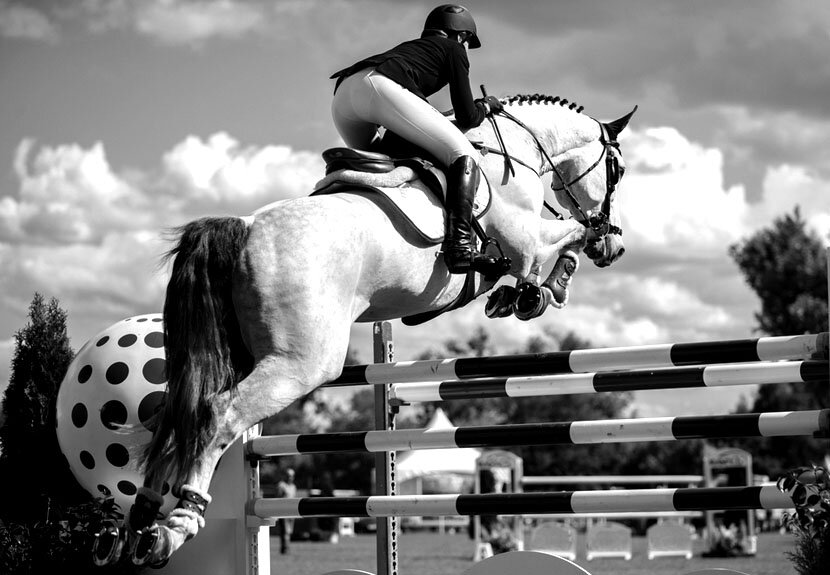
IRAP JOINT THERAPY
Degenerative joint disease is one of the biggest causes of poor performance and a decreased competitive lifespan in the horse. This is true for all types of equine athletes, from racehorses through to dressage and show horses. Both young and old horses can be affected by degenerative joint disease resulting in a loss of athletic ability and possible early retirement.
Joint disease/ osteoarthritis is characterized by inflammation within a joint that sparks an inflammatory cascade resulting in the production of a large amount of inflammatory enzymes. Often the process of joint disease is characterized by an inflammation of the synovium (lining of the joint capsule) followed by the progressive destruction of articular cartilage. The development of joint disease can often progress un-noticed because the onset of lameness can be insidious. Often, it is not until an obvious lameness develops that the presence of degenerative joint disease is noticed.
The degree of the lameness when it is first reported can vary from mild to severe. The grading scale we use to quantify lameness runs from as scale of 0 to 10 with zero being a sound horse and 10 being a horse non-weight bearing on the limb in question. Please feel free to read the information on our website explaining our approach to the diagnosis and management of lameness.
IRAP is an effective intra-articular treatment for joint disease. The IRAP system has been designed to stimulate the horses’ own white blood cells to produce anti-inflammatory mediators and enzymes that can reduce the inflammation present as a result of degenerative joint disease. Initially blood is collected from the jugular vein and incubated for 24 hours in special syringes that contain glass beads that induce the white blood cells present in the blood to produce and secrete therapeutic proteins. After 24 hours the blood is centrifuged and the serum is separated from the red blood cells. The protein rich serum is then split into 3ml doses and the separate doses are frozen for use at a later date. Typically each collection produces enough serum for between 6-8 injections. It is important to note that the injections are only suitable to treat the horse from which the original blood was collected. The injections can be stored for up to 12 months from the date of collection.
When injected into a joint, the protein rich serum stimulates a regenerative response from cartilage cells, through a process of cell division and increased cell recruitment. This is actually what sets IRAP apart from other intra-articular treatments for joint disease. The fact that IRAP stimulates cartilage cells means that it has a disease modifying component as well as an anti-inflammatory component. The serum also contains cytokines that act to reduce inflammation within the joint. In addition there are other anti-inflammatory proteins produced during the incubation process that work synergistically with the cytokines to further reduce the inflammation within the diseased joint.
IRAP Joint Therapy
This short video will explain the process of how we make IRAP and also the common treatment options.
What does the treatment involve?
The therapy involves three joint injections at 7 day intervals. Most positive effects are seen after the second and the third treatment and the majority of horses will be sound after the third injection. In our hands, more than 90% of horses have returned to soundness after IRAP therapy. Once the horse is sound, the horse can resume normal work. If lameness returns after a period of time, any remaining frozen samples can be defrosted and the injections repeated. Often a single injection will suffice at this point and it is unusual for most horses to need to repeat the full course of three injections. However, individual cases can vary and each case will need to be reassessed by your veterinarian if lameness returns.
What cases warrant the use of IRAP?
The cases that generally respond the best to IRAP therapy are those with mild to moderate radiographic signs of degenerative joint disease where all signs of lameness have been abolished by administration of an intra-articular nerve block. Use of an intra-articular nerve block confirms that the lameness is entirely due to pathology within the joint and that there is no soft tissue involvement.
Joints where there are fragments of bone (chips) visible on radiographs are not suitable candidates for this therapy. However, IRAP is very useful after arthroscopic removal of any chip fragments. In these cases the anti-inflammatory cytokines and proteins reduce inflammation within the joint and encourage a regeneration response from the damaged cartilage. In post surgical cases, we recommend administering the first IRAP treatment between 14 and 21 days after surgery. We recommend that post surgical cases receive the full course of three injections at one week intervals.
Why use IRAP?
IRAP is different from other products because it treats the cause of joint disease and its’ action is aimed at restoring joint lining and cartilage function. Studies performed at Colorado State University show that treated horses demonstrate reduced lameness, improved joint histology (cellular make up) and a tendency towards cartilage preservation. Our clinic has seen resolution of lameness, a general improvement in the range of motion of the joint and a decrease in joint effusion in treated horses.
Traditionally the most common intra-articular medication for the management of joint disease has been cortisone injections. Clinically, with cortisone injections we often see a sudden response and improvement in the degree of lameness that then gradually wears off over a period of time. When cortisone injections are repeated we often see a decrease in the interval between treatments. Meaning, that the more cortisone injections a horse has into a particular joint, the shorter the duration of therapeutic effect and the sooner that joint will need to be treated again. The use of IRAP often allows us to delay the use of cortisone injections and prolong the athletic life of the horse. In many cases where there has been a very good response to IRAP therapy, cortisone injections to manage the degenerative joint disease can be delayed indefinitely.

IRAP therapy in our hands has been very beneficial in the management of early joint disease in certain joints more specifically.
We have found the treatment very useful in the management for arthritis of the following joints:
Coffin joints
Fetlock joints
Tarso-metatarsal joints of the hocks.
Post surgical removal of fragments from a joint we have found the IRAP therapy to be useful in any joint where a fragment has been removed. We have found horses treated post surgery have reduced signs of arthritic change within a joint on radiographs and there is a reduced need to use joint medications when the horse resumes training.
Another advantage to using IRAP therapy, is that it does not have some of the same side effects as cortisone. The use of IRAP therapy does not increase the risk of laminitis and there is a smaller risk of joint infection using IRAP compared with using cortisone. There have been a few reported cases of reaction to IRAP serum with a ‘flare’ response seen within 24hrs of injection. This is an uncommon side effect that subsides after administration of systemic corticosteroids and application of ice to the joint.
Overall, IRAP has been a welcome addition to the armoury of treatments we have for degenerative joint disease. If you would like to discuss the suitability of IRAP as a treatment for your horse, please contact our office and one of our veterinarians will be happy to discuss your case.
Book a IRAP Therapy Appointment
info@tevs.com.au
03 59775250
Somerville, Victoria
The world class results achieved by our practice in respect of these injuries, do not just reflect our own expertise, but also reflect the commitment of the trainers and owners involved. To achieve the best results for your horse, success will lie not only in the investment of money in this treatment, but also in the time and effort devoted to completion of our prescribed rehabilitation program.



